Related Research Articles

Salacca is a genus of about 20 species of palms native to Southeast Asia and the eastern Himalayas. They are dioecious and pollinated by Curculionidae beetles.
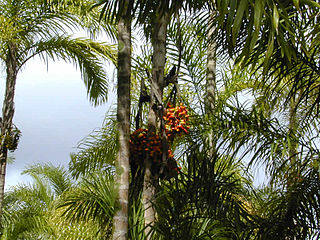
Bactris is a genus of spiny palms which are native to Mexico, South and Central America and the Caribbean. Most species are small trees about 2 m tall, but some are large trees while others are shrubs with subterranean stems. They have simple or pinnately compound leaves and yellow, orange, red or purple-black fruit. The genus is most closely related to several other spiny palms—Acrocomia, Aiphanes, Astrocaryum and Desmoncus. The fruit of several species is edible, most notably B. gasipaes, while others are used medicinally or for construction.
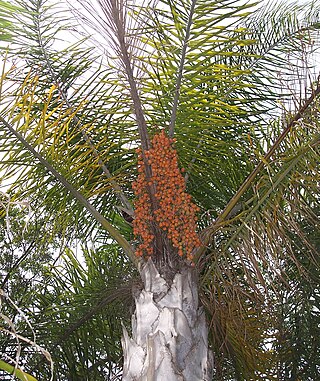
Syagrus is a genus of Arecaceae (palms), native to South America, with one species endemic to the Lesser Antilles. The genus is closely related to the Cocos, or coconut genus, and many Syagrus species produce edible seeds similar to the coconut.

Calyptrogyne is a genus in the palm family (Arecaceae). It is distributed across Central America, Colombia, and southern Mexico, with 11 of the 17 known species endemic to Panama. Calyptrogyne ghiesbreghtiana is the most widespread and best studied species in this genus.

Attalea speciosa, the babassu, babassu palm, babaçu, or cusi, is a palm native to the Amazon Rainforest region in South America. The babassu palm is the predominant species in the Maranhão Babaçu forests of Maranhão and Piauí states.
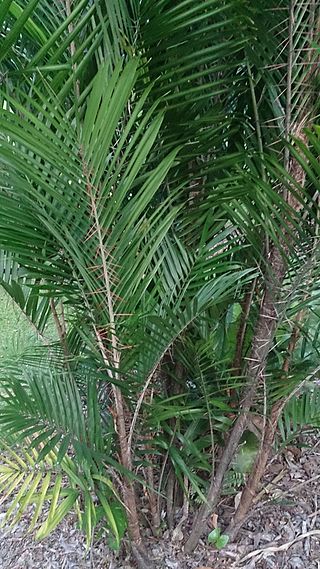
Bactris major is a small to medium-sized spiny palm which ranges from Mexico, through Central America into northern South America and Trinidad. The species is divided into three or four varieties, although the boundaries between varieties is not always clearly defined.
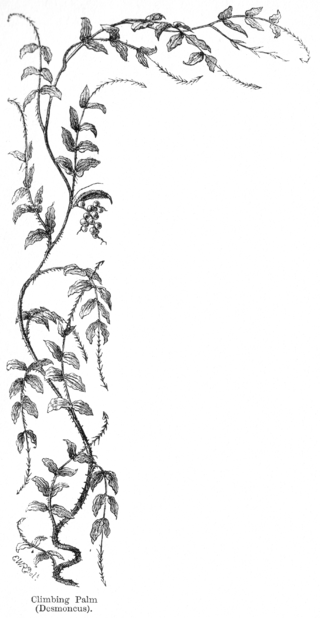
Desmoncus is a genus of mostly climbing, spiny palms native to the Neotropics. The genus extends from Mexico in the north to Brazil and Bolivia in the south, with two species present in the southeastern Caribbean.

Oenocarpus is a genus of pinnate-leaved palms (Arecaceae) native to Trinidad, southern Central and tropical South America. With nine species and one natural hybrid, the genus is distributed from Costa Rica and Trinidad in the north to Brazil and Bolivia in the south.

Geonoma is a genus of small to medium-sized palms native to the forest understorey of tropical Central and South America.
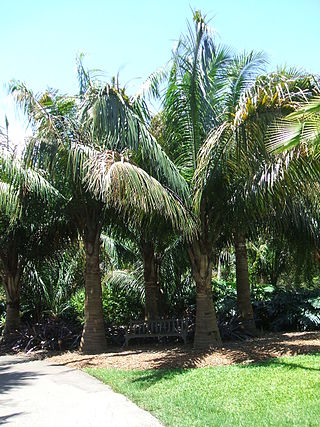
Attalea crassispatha is a palm which is endemic to southwest Haiti. The most geographically isolated member of the genus, it is considered a critically endangered species and has been called one of the rarest palms in the Americas.

Attalea is a large genus of palms native to Mexico, the Caribbean, Central and South America. This pinnately-leaved, non-spiny genus includes both small palms lacking an aboveground stem and large trees. The genus has a complicated taxonomic history, and has often been split into four or five genera based on differences in the male flowers. Since the genera can only be distinguished on the basis of their male flowers, the existence of intermediate flower types and the existence of hybrids between different genera has been used as an argument for keeping them all in the same genus. This has been supported by recent molecular phylogenies.

Asterogyne is a genus of flowering plant in the family Arecaceae native to Central America and northern South America, with three of the five known species endemic to Venezuela.

Linospadix is a genus of flowering plant in the family Arecaceae. It is native to New Guinea and Australia.

Pinanga is a genus of flowering plant of the palm family in the subtribe Arecinae. It is native to eastern and southern Asia across to New Guinea.

Wettinia is a genus of flowering plants in the palm family Arecaceae. The genus, established in 1837, contains some 20 species, but more seem to await discovery considering that 4 species - W. aequatorialis, W. lanata, W. minima and W. panamensis - were described as late as 1995. The genus is broadly divided into two groups. One group has the fruits tightly packed, while the other, formerly classified as genus Catoblastus, has fruits scattered along the inflorescence branches. It is not known whether these groups are both monophyletic. The genus is named after Frederick Augustus II of Saxony, of the House of Wettin.

Euterpe precatoria is a tall, slender-stemmed, pinnate-leaved palm native to Central and South America and Trinidad and Tobago. E. precatoria is used commercially to produce fruits, although Euterpe oleracea is more commonly cultivated due to its larger fruits.
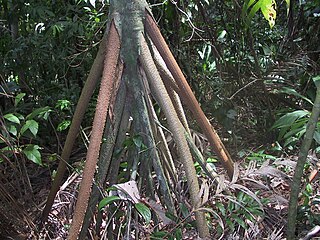
Socratea is a genus of five species of palms found in tropical Central America and South America.

Pholidostachys is a genus of palms found in Central America and northwestern South America.

Acrocomia is a genus of palms which is native to the Neotropics, ranging from Mexico in the north, through Central America and the Caribbean, and through South America south to Argentina.

Butia stolonifera was an oddly growing palm assigned to the genus Butia found only once in Uruguay in the 19th century, but which now is considered to be uncertain as a valid species.
References
- 1 2 3 4 Pintaud, Jean-Christophe (2008). "An overview of the taxonomy of Attalea (Arecaceae)" (PDF). Revista Peruana de Biología. 15 (supl. 1): 055–063.
- ↑ Anderson, Anthony B.; Michael J. Balick (1988). "Taxonomy of the Babassu Complex (Orbignya spp.: Palmae)" (PDF). Systematic Botany. 13 (1): 32–50. doi:10.2307/2419239. JSTOR 2419239.
- ↑ Freitas, Cintia; Meerow, Alan W.; Pintaud, Jean-Christophe; Henderson, Andrew; Noblick, Larry; Costa, Flavia R. C.; Barbosa, Carlos E.; Barrington, David (2016). "Phylogenetic analysis of Attalea (Arecaceae): insights into the historical biogeography of a recently diversified Neotropical plant group". Botanical Journal of the Linnean Society. 182 (2): 287–302. doi: 10.1111/boj.12466 .
- ↑ Henderson, Andrew (1995). The palms of the Amazon. Oxford University Press. ISBN 978-0-19-508311-8.
- ↑ Balick et al.. 1987, Anderson and Balick 1988
- ↑ "Attalea allenii H.E.Moore, Gentes Herbarum 8: 191 (1949)". World Checklist of Selected Plant Families. Retrieved 2019-04-27.
- ↑ "Attalea amygdalina Kunth in F.W.H.von Humboldt, A.J.A.Bonpland & C.S.Kunth, Nov. Gen. Sp. 1: 310 (1816)". World Checklist of Selected Plant Families. Retrieved 2019-04-27.
- ↑ "Attalea amylacea (Barb.Rodr.) Zona, Palms 46: 132 (2002)". World Checklist of Selected Plant Families. Retrieved 2019-04-27.
- ↑ "Attalea anisitsiana (Barb.Rodr.) Zona, Palms 46: 132 (2002)". World Checklist of Selected Plant Families. Retrieved 2019-04-27.
- ↑ "Attalea apoda Burret, Repert. Spec. Nov. Regni Veg. 32: 105 (1933)". World Checklist of Selected Plant Families. Retrieved 2019-04-27.
- ↑ "Attalea attaleoides (Barb.Rodr.) Wess.Boer, Indig. Palms Surin.: 157 (1965)". World Checklist of Selected Plant Families. Retrieved 2019-04-27.
- ↑ "Attalea barreirensis Glassman, Illinois Biol. Monogr. 59: 25 (1999)". World Checklist of Selected Plant Families. Retrieved 2019-04-27.
- ↑ "Attalea bassleriana (Burret) Zona, Palms 46: 132 (2002)". World Checklist of Selected Plant Families. Retrieved 2019-04-27.
- ↑ "Attalea brasiliensis Glassman, Illinois Biol. Monogr. 59: 65 (1999)". World Checklist of Selected Plant Families. Retrieved 2019-04-27.
- ↑ "Attalea brejinhoensis (Glassman) Zona, Palms 46: 132 (2002)". World Checklist of Selected Plant Families. Retrieved 2019-04-27.
- ↑ "Attalea burretiana Bondar, Bol. Inst. Centr. Fomento Econ. Bahia 12: 30, 63 (1942)". World Checklist of Selected Plant Families. Retrieved 2019-04-27.
- ↑ "Attalea butyracea (Mutis ex L.f.) Wess.Boer, Pittieria 17: 312 (1988)". World Checklist of Selected Plant Families. Retrieved 2019-04-27.
- ↑ "Attalea camopiensis (Glassman) Zona, Palms 46: 132 (2002)". World Checklist of Selected Plant Families. Retrieved 2019-04-27.
- ↑ "Attalea cephalotus Poepp. ex Mart. in A.D.d'Orbigny, Voy. Amér. Mér. 7(3): 119 (1844)". World Checklist of Selected Plant Families. Retrieved 2019-04-27.
- ↑ "Attalea cohune Mart. in A.D.d'Orbigny, Voy. Amér. Mér. 7(3): 121 (1844)". World Checklist of Selected Plant Families. Retrieved 2019-04-27.
- ↑ "Attalea colenda (O.F.Cook) Balslev & A.J.Hend., Brittonia 39: 1 (1987)". World Checklist of Selected Plant Families. Retrieved 2019-04-27.
- ↑ "Attalea compta Mart., Hist. Nat. Palm. 2: 137 (1826)". World Checklist of Selected Plant Families. Retrieved 2019-04-27.
- ↑ "Attalea crassispatha (Mart.) Burret, Kongl. Svenska Vetensk. Acad. Handl., ser. 3, 6(7): 23 (1929)". World Checklist of Selected Plant Families. Retrieved 2019-04-27.
- ↑ "Attalea cuatrecasasiana (Dugand) A.J.Hend., Galeano & R.Bernal, Field Guide to the Palms of the Americas: 265 (1995)". World Checklist of Selected Plant Families. Retrieved 2019-04-27.
- ↑ "Attalea dahlgreniana (Bondar) Wess.Boer, Indig. Palms Surin.: 158 (1965)". World Checklist of Selected Plant Families. Retrieved 2019-04-27.
- ↑ "Attalea degranvillei (Glassman) Zona, Palms 46: 132 (2002)." World Checklist of Selected Plant Families. Retrieved 2019-04-27.
- ↑ "Attalea dubia (Mart.) Burret, Notizbl. Bot. Gart. Berlin-Dahlem 10: 516 (1929)". World Checklist of Selected Plant Families. Retrieved 2019-04-27.
- ↑ "Attalea eichleri (Drude) A.J.Hend., Palms Amazon: 143 (1995)". World Checklist of Selected Plant Families. Retrieved 2019-04-27.
- ↑ "Attalea exigua Drude in C.F.P.von Martius & auct. suc. (eds.), Fl. Bras. 3(2): 439 (1881)". World Checklist of Selected Plant Families. Retrieved 2019-04-27.
- ↑ "Attalea fairchildensis (Glassman) Zona, Palms 46: 132 (2002)". World Checklist of Selected Plant Families. Retrieved 2019-04-27.
- ↑ "Attalea funifera Mart., Hist. Nat. Palm. 2: 136 (1826)". World Checklist of Selected Plant Families. Retrieved 2019-04-27.
- ↑ "Attalea geraensis Barb.Rodr., Pl. Jard. Rio de Janeiro 6: 22 (1898)". World Checklist of Selected Plant Families. Retrieved 2019-04-27.
- ↑ "Attalea guacuyule (Liebm. ex Mart.) Zona, Palms 46: 133 (2002)". World Checklist of Selected Plant Families. Retrieved 2019-04-27.
- ↑ "Attalea guianensis (Glassman) Zona, Palms 46: 133 (2002)". World Checklist of Selected Plant Families. Retrieved 2019-04-27.
- ↑ "Attalea hoehnei Burret, Notizbl. Bot. Gart. Berlin-Dahlem 10: 522 (1929)". World Checklist of Selected Plant Families. Retrieved 2019-04-27.
- ↑ "Attalea huebneri (Burret) Zona, Palms 46: 133 (2002)". World Checklist of Selected Plant Families. Retrieved 2019-04-27.
- ↑ "Attalea humilis Mart. ex Spreng., Syst. Veg. 2: 624 (1825)". World Checklist of Selected Plant Families. Retrieved 2019-04-27.
- ↑ "Attalea iguadummat de Nevers, Ann. Missouri Bot. Gard. 74: 506 (1987)". World Checklist of Selected Plant Families. Retrieved 2019-04-27.
- ↑ "Attalea insignis (Mart.) Drude in H.G.A.Engler & K.A.E.Prantl (eds.), Nat. Pflanzenfam., Nachtr. 1: 56 (1897)". World Checklist of Selected Plant Families. Retrieved 2019-04-27.
- ↑ "Attalea kewensis (Hook.f.) Zona, Palms 46: 133 (2002)". World Checklist of Selected Plant Families. Retrieved 2019-04-27.
- ↑ "Attalea lauromuelleriana (Barb.Rodr.) Zona, Palms 46: 133 (2002)". World Checklist of Selected Plant Families. Retrieved 2019-04-27.
- ↑ "Attalea leandroana (Barb.Rodr.) Zona, Palms 46: 133 (2002)". World Checklist of Selected Plant Families. Retrieved 2019-04-27.
- ↑ "Attalea luetzelburgii (Burret) Wess.Boer, Pittieria 17: 303 (1988)". World Checklist of Selected Plant Families. Retrieved 2019-04-27.